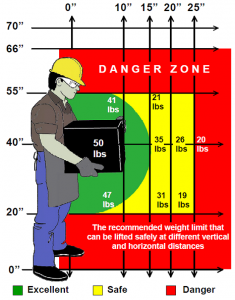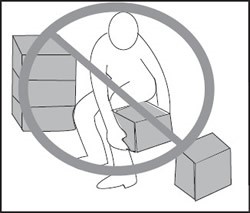Preventing Back Injuries
Back injuries can be extremely painful and long-lasting. According to the Federal Bureau of Labor Statistics, the back injuries of more than 1 million workers account for nearly 20 percent of all injuries and illnesses in the workplace.
Several factors may increase the onset of acute or chronic back pain, including:
- Lifting incorrectly
- Carrying objects incorrectly
- Pushing or pulling heavy objects
- Frequent back bending
- Poor posture
- Being overweight
- Lack of physical fitness
- Inadequate tools
- Environmental barriers
Your Safe Lifting Zone is between your hips and shoulders. Lifting and carrying objects in this area is considered proper body mechanics and provides the best chance for minimizing injury.
Your At-Risk Zone is below the knees or above your head. When you try to lift in this area, your back muscles have to work harder, which may result in an injury. To protect your back when you must lift in your At-Risk Zone:
- Maintain a solid base of support with your feet
- Bend with your legs, not your back
- Lift weight using your arm and leg muscles.

Your Danger Zone is below your knees and 12 inches and greater in front of your feet. This is where your back is most vulnerable to injury because it necessitates bending and reaching. To protect your back when you must lift in the Danger Zone:
- Lighten your load
- Move feet as close to load as possible
- Bend with your legs, not your back
- If you must reach: Bend at the hips
- Make smooth, consistent movements.
Here is a quick checklist of safe lifting techniques:
- Plan the lift.
- Size up the load.
- Establish a base.
- Get a good grip.
- Lift steadily.
- Keep it close.
- Move your feet.
Or, for a list with a little more detail...
Preparing for the lift:
- Size up the load. Test the weight before you try to lift. If it's too heavy, divide it up, get help from a co-worker, or use a machine, dolly, or cart to assist you.
- Survey your route. Look for hazards such as spills, uneven surfaces, corners, and flooring changes.
Performing the lift:
- Make sure your mind is on the job, your spine is in its neutral "S" curve posture, and you are in your Safe Lifting Zone.
- Get as close to the load as you can.
- With feet shoulder-width apart, either squat down with both feet equally squared or put one foot in front of the other using a diagonal squat.
- When performing the diagonal squat, bend at the hip not with your back, to lean over your forward leg.
- Keep your spine in its natural "S" curve and let your legs do the lifting.
- Lower down to one knee.
- Hold the load close to your body as you squat.
- Balance the load on your other knee.
- Pause to adjust your grip, and set down.
Carrying and lowering:
- If you have to turn, aim one foot toward your destination.
- Use your feet to pivot, don't twist with your back.
- Set the load down in one slow movement.
- Carrying heavy loads in your Safe Lifting Zone.
- Store heavy items at waist level.
- If the load is heavy or bulky, use a cart or dolly instead of carrying.

Visit the University Safety and Risk Management website for more information about reporting hazards on campus. Thank you, for helping us keep our campus safe!
